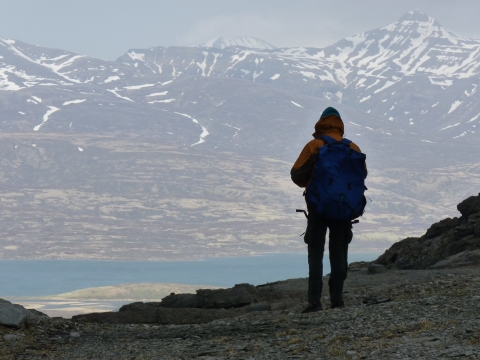Visit Us
National wildlife refuges offer us all a chance to unplug from the stresses of daily life and reconnect with our natural surroundings. The Refuge offers a variety of recreational opportunities, including sport fishing and hunting, observing and photographing wildlife, hiking, backpacking, boating, and camping. While on the Refuge, you are truly in a wild place, with spectacular views and a high probability for danger, including interactions with wildlife and hypothermia. Refuge lands are remote and accessible only by small aircraft, boat, or rugged cross country hiking. There are no roads or maintained trails and help can be hours or even days away if something goes wrong. Please prepare accordingly.
Commercial Use
All commercial activity on the Refuge, including guiding and transporting, requires a Special Use Permit. Contact the Refuge office for information. Commercial, recreational, and subsistence activities are monitored to assure these activities do not significantly impact wildlife populations and their habitats.
Private Land
There are many parcels of private land within the boundaries of the refuge, and not all owners have marked their land. Most cabin sites are private property. Please respect all private property and get the landowner’s permission before entering.
Trails
The Kanatak Trail is an historic route used for centuries to cross between the Pacific Ocean and Bristol Bay via Becharof Lake. Archeological work places residents on the Pacific end of the route at least 1,900 years ago. Early Russian and American explorers continued to use the route with settlements at both ends of the trail and at Ruth Lake. Oil exploration in the early part of the twentieth century brought hundreds of settlers to the Pacific village of Kanatak, and during this time primitive unpaved roads were built over the old walking route. When the last residents of Kanatak left in the mid-1950s, the trail fell out of regular use.
Unlike trails near urban centers, the Kanatak Trail is in a remote and primitive natural setting. No road leads here and hikers are unlikely to see other people on the trail. The challenges of access, weather, and terrain ensure a unique and wild experience.
Views from the trail extend to Mount Peulik volcano, the designated Becharof Wilderness bordering Katmai National Park, and the rugged coastal mountains. Many changes in vegetation can be observed along the trail. Visiting photographers are often rewarded in this remote land of constant change. Wildlife viewing on the route can be excellent with recorded sightings of brown bear, caribou, red fox, two types of ptarmigan, marmot, beaver, ground squirrel, sea and land otter, and harbor seal. Angling in Ruth River can yield grayling, Dolly Varden char, and salmon.
The Kanatak Trail in Becharof National Wildlife Refuge captures a human story in a wild landscape. This unique trail honors the resourceful people of the Peninsula, and provides an unusual educational and recreational experience for today’s visitor.
Hiking The Kanatak Trail
Floatplanes or boats can access the western end of the trail from the southern end of Becharof Lake’s Island Arm. Access may be possible from the eastern end of the route via beach landings by airplane or boat, depending on tides and weather. Access, weather, wildlife, and terrain can be challenging; local guidance is strongly advised. Please call the USFWS office in King Salmon or the King Salmon Visitor Center for assistance before making plans.

